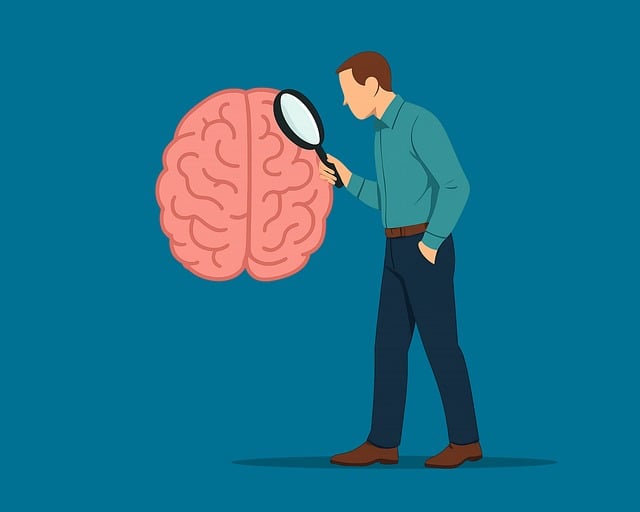Addressing Mental Illness Stigma: Media’s Role & Colorado Springs Cognitive Processing Therapy Solutions
Media portrayal significantly shapes societal views on mental health, with accurate and compassionat…….
In the realm of mental health treatment, Colorado Springs Cognitive Processing Therapy (CSPT) has emerged as a pioneering approach, offering innovative solutions for individuals grappling with various cognitive and emotional challenges. This therapy, developed in the vibrant city of Colorado Springs, CO, USA, has gained international recognition for its effectiveness in addressing complex psychological issues. In this article, we embark on a comprehensive journey through the world of CSPT, exploring its principles, impact, and potential to transform lives. By delving into its history, applications, and future prospects, readers will gain valuable insights into this powerful therapeutic modality.
Colorado Springs Cognitive Processing Therapy is a highly structured form of psychotherapy that focuses on modifying maladaptive thought patterns and behaviors. It was developed by Dr. David A. Carbonell, a clinical psychologist, to help individuals overcome trauma, anxiety, depression, and other psychological struggles. CSPT draws from various therapeutic modalities, including cognitive-behavioral therapy (CBT), exposure therapy, and eye movement desensitization and reprocessing (EMDR).
The core components of CSPT include:
Identifying Maladaptive Thought Patterns: Therapists assist clients in recognizing negative or distorted thinking patterns that contribute to emotional distress. These patterns can be related to self-worth, perceptions of the world, or interpretations of past events.
Cognitive Restructuring: This involves challenging and replacing maladaptive thoughts with more realistic and positive ones. Clients learn to question their automatic negative thoughts (ANTs) and develop a healthier mindset.
Exposure Therapy Techniques: CSPT incorporates exposure therapy to help clients confront and process traumatic memories or feared situations in a safe and controlled manner. This process facilitates desensitization and reduces anxiety over time.
Eye Movement Integration: Similar to EMDR, CSPT utilizes eye movements (or alternative methods) to help clients process traumatic memories and associated emotions. This technique is believed to facilitate the brain’s natural healing process.
The roots of CSPT can be traced back to the late 20th century when cognitive-behavioral therapy was gaining traction as a leading evidence-based practice. Dr. Carbonell, driven by his clinical experience, identified gaps in existing therapeutic approaches, particularly in treating complex trauma and its subsequent anxiety disorders. He spent years refining his technique, combining elements from various successful therapies to create CSPT.
In the early 2000s, CSPT began to gain recognition within the mental health community. Dr. Carbonell’s book, “Get Over It: Overcoming Trauma and Anxiety with Cognitive Processing Therapy,” published in 2015, became a seminal work, introducing the therapy to a wider audience. This publication, along with numerous research studies, has contributed to CSPT’s growing popularity worldwide.
Colorado Springs Cognitive Processing Therapy has transcended geographical boundaries, captivating mental health professionals and researchers globally. Its effectiveness in treating post-traumatic stress disorder (PTSD), anxiety disorders, and other trauma-related conditions has sparked interest across diverse cultures and healthcare systems. Today, CSPT is offered in numerous countries, including the UK, Australia, Canada, and various European nations.
Growing Evidence Base: Ongoing research continues to strengthen the evidence supporting CSPT’s efficacy. Randomized controlled trials (RCTs) have demonstrated its superiority over other therapies in treating specific conditions, leading to increased adoption by healthcare providers.
Integrating Technology: The digital age has brought about innovative ways to deliver CSPT. Online therapy platforms and mobile apps are being developed to make this treatment accessible to a broader audience, especially those in remote areas or with limited mobility.
Cultural Adaptation: As CSPT spreads globally, therapists are adapting it to suit different cultural contexts. This involves translating therapeutic materials and techniques while ensuring cultural sensitivity and effectiveness.
North America: In the United States and Canada, CSPT is widely practiced within private clinics and healthcare systems. It is often used in conjunction with other evidence-based practices, such as mindfulness-based therapies.
Europe: European countries have embraced CSPT, with many therapists integrating it into their practice. The UK, for instance, has seen a rise in CSPT training programs for psychologists and counselors.
Asia and Pacific: In regions like Australia and New Zealand, CSPT is gaining popularity as an effective treatment for trauma-related disorders. Cultural adaptations are being made to cater to diverse client populations.
The global mental health market, valued at USD 362 billion in 2021 (Source: Grand View Research), presents a significant opportunity for CSPT. As the demand for evidence-based therapies grows, CSPT’s focus on treating complex trauma and anxiety disorders aligns perfectly with current healthcare needs.
Investment in mental health technology, including digital CSPT platforms, is expected to rise, driven by the need for accessible and cost-effective treatment options. This trend opens up new avenues for CSPT practitioners to reach a larger client base.
Healthcare Costs: By effectively treating conditions such as PTSD and anxiety disorders, CSPT can contribute to reducing healthcare expenditures associated with chronic mental health issues.
Productivity and Well-being: Improved mental health through CSPT can lead to higher productivity in the workplace, reduced absenteeism, and enhanced overall well-being in communities.
Social Support Systems: As CSPT becomes more accessible, it can strengthen social support networks, leading to better coping mechanisms and reduced reliance on traditional healthcare services.
Online Therapy Platforms: Telehealth solutions enable clients to access CSPT remotely, breaking down geographical barriers. These platforms offer live video sessions, secure messaging, and digital tools for cognitive restructuring.
Mobile Applications: Dedicated apps provide daily exercises and resources to support between-session work. Features include mood tracking, guided meditations, and personalized cognitive restructuring activities.
Virtual Reality (VR) Therapy: VR is being explored as a tool within CSPT to create controlled exposure environments for phobia and trauma treatment. This technology offers an immersive experience, enhancing the therapeutic process.
Technological advancements have expanded the reach and accessibility of CSPT, allowing therapists to cater to diverse client needs. Online and mobile tools empower clients to engage actively in their recovery, while VR offers innovative exposure therapy options. As technology continues to evolve, CSPT is poised to become even more effective and widely available.
The provision of CSPT, like many therapeutic services, is subject to various policies and regulations that vary by region:
Licensing and Certification: Therapists delivering CSPT must be licensed or certified according to local laws. These regulations ensure professionals meet educational and training standards.
Privacy and Confidentiality: Laws such as HIPAA (Health Insurance Portability and Accountability Act) in the US protect client privacy and confidentiality during therapy sessions.
Insurance Coverage: The extent to which CSPT is covered by insurance policies varies globally. In some regions, it is a recognized treatment modality, while in others, it may require out-of-pocket expenses.
Policies and regulations play a crucial role in shaping the practice of CSPT:
Standardization: Licensing requirements ensure a minimum level of competence among therapists, fostering trust among clients.
Accessibility: Insurance coverage policies can encourage healthcare providers to offer CSPT, making it more accessible to those who need it.
Ethical Guidelines: Regulatory bodies establish ethical standards, ensuring therapists prioritize client well-being and maintain professional boundaries.
Stigma and Misunderstanding: Despite its evidence-based foundation, CSPT sometimes faces stigma and misconceptions. Educating the public and healthcare professionals about its effectiveness is essential for wider acceptance.
Training and Education: Ensuring therapists receive adequate training in CSPT is critical. Continuous education programs can help maintain high standards of practice.
Resource Allocation: Implementing CSPT on a large scale may require significant investment in training, technology, and clinical resources, posing challenges for healthcare systems.
Public Awareness Campaigns: Raising awareness through informative campaigns can dispel myths and encourage individuals to seek CSPT for mental health issues.
Integrated Training Programs: Developing comprehensive training modules that incorporate CSPT into existing therapeutic curricula can improve its accessibility within the profession.
Government Support and Partnerships: Collaboration between healthcare providers, government bodies, and insurance companies is crucial for resource allocation and policy advocacy.
John, a 55-year-old veteran, suffered from severe PTSD after serving in a war zone. He experienced nightmares, flashbacks, and intense anxiety in social situations. Through CSPT, John worked with his therapist to identify and challenge his traumatic memories. Eye movement exercises helped him process these memories, reducing their emotional impact. Over several sessions, John learned coping strategies and gradually regained control over his life. Today, he is actively involved in veteran support groups, sharing his recovery journey.
Sarah, a young professional, struggled with generalized anxiety disorder and major depressive disorder. CSPT helped her understand the connection between her thoughts and emotions. By restructuring negative thought patterns, Sarah learned to manage her anxiety and depression effectively. The therapist also incorporated mindfulness techniques, which Sarah practiced daily. Within a few months, she reported significant improvements in her mood, sleep, and overall quality of life.
Michael, a 24-year-old, had a severe fear of flying that significantly impacted his travel plans and career aspirations. CSPT exposure therapy sessions helped him confront his fears gradually. Through guided visualizations and in-vivo exposures, Michael learned to manage his anxiety during flights. With each successful step, his confidence grew, allowing him to travel for work without extreme distress.
Cultural Diversity and Adaptability: As CSPT continues to gain global traction, further cultural adaptations will be necessary to cater to diverse client populations.
Integration with Other Therapies: Researchers are exploring ways to combine CSPT with other evidence-based practices, such as mindfulness and acceptant-based therapy, to enhance treatment outcomes.
Digital Health Innovation: The future of CSPT is likely to be closely tied to digital technology, with ongoing development of advanced online platforms and mobile applications.
AI-Assisted Therapy: Artificial intelligence (AI) has the potential to revolutionize mental health care, including CSPT. AI-driven tools can provide personalized therapy exercises and support between sessions.
Neurofeedback Training: Neurofeedback is a technique that provides real-time feedback on brain activity, helping clients learn self-regulation. When combined with CSPT, it may offer enhanced cognitive restructuring benefits.
Group Therapy Sessions: While CSPT is often delivered individually, group therapy sessions could become more prevalent, providing peer support and reducing treatment costs.
Colorado Springs Cognitive Processing Therapy has emerged as a powerful therapeutic tool, offering hope and healing to individuals facing various psychological challenges. Its global impact, supported by robust research, underscores its effectiveness in treating trauma-related disorders and anxiety. As technology advances and cultural adaptations are made, CSPT is poised to play an increasingly vital role in mental health care worldwide.
By addressing barriers, embracing new technologies, and fostering ongoing research, the future of CSPT looks bright. This therapy has the potential to touch countless lives, providing a path to recovery and improved well-being for those who need it most. As we continue to explore and refine this approach, the global mental health community moves closer to its goal of delivering evidence-based care to all.
Q: What makes CSPT different from other forms of therapy?
A: CSPT stands out for its structured, cognitive-focused approach. It combines elements from multiple therapeutic modalities to address maladaptive thought patterns and emotional responses, making it particularly effective for specific conditions like trauma and anxiety disorders.
Q: Is CSPT suitable for all ages?
A: While CSPT has been successfully used with adults, adolescents, and even children (with adapted techniques), individual therapist expertise and client needs should guide treatment recommendations.
Q: How long does therapy typically take with CSPT?
A: The duration of treatment varies depending on the severity of symptoms and client progress. On average, a typical course of CSPT can range from 12 to 20 sessions, but some clients may require more or fewer.
Q: Can CSPT be combined with other treatments?
A: Absolutely. Many therapists integrate CSPT with other evidence-based practices like mindfulness training or medication management to provide comprehensive care tailored to each client’s unique needs.
Q: Is there scientific evidence supporting CSPT’s effectiveness?
A: Yes, numerous randomized controlled trials have demonstrated the efficacy of CSPT in treating specific conditions, such as PTSD, social anxiety disorder, and major depressive disorder. The evidence base continues to grow, reinforcing its place as a powerful therapeutic tool.

Media portrayal significantly shapes societal views on mental health, with accurate and compassionat…….

Stress management in Colorado Springs leverages Cognitive Processing Therapy (CPT), mindfulness, and…….